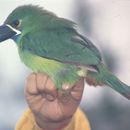en
names in breadcrumbs


Perception Channels: visual ; tactile ; acoustic ; chemical
Emerald Toucanets were not found in any of these endangered species databases. However, the importance being placed on the coffee market may someday have a negative effect of survival for this species. (Henriquez 1999).
US Migratory Bird Act: no special status
US Federal List: no special status
CITES: no special status
IUCN Red List of Threatened Species: least concern
Emerald Toucanets have been identified as a seed disperser for several rainforest trees. Studies indicate that the germination rate of seeds of these trees is higher following the seeds passing through the digestive tract of the bird. (Wenny 2000).
Ecosystem Impact: disperses seeds
Emerald Toucanets are omnivorous, eating lizards and the eggs or nestlings of other birds when possible, though insects and fruits are the largest part of their diet. (Terres 1980).
Neotropical: Emerald Toucanets, Aulacorhynchus prasinus are found abundantly in Central and South America, mostly along the eastern coast. They are sparse in the eastern-central parts of Mexico and exist more densely in the southern mountainous parts down through Costa Rica and Panama into the northernmost part of Venezuela. (Campbell 1974, USGS 2001, Peterson 1973).
Their native habitats are in Mexico, Costa Rica, and Panama in the higher elevation cloud forests. They have recently expanded their range into lower elevation rain forest. Emerald Toucanets will make their home at elevations from 915 m up to 3050 m (3,000 feet - 10,000 feet). They migrate vertically from lower elevation to higher elevation. (Campbell 1974, Peterson 1973, USGS 2001).
Range elevation: 915 to 3050 m.
Habitat Regions: temperate ; terrestrial
Terrestrial Biomes: rainforest
Range lifespan
Status: wild: 10 (low) years.
Average lifespan
Status: wild: 11.00 years.
Range lifespan
Status: captivity: 12 to 14 years.
The male and female are monomorphic (alike) in color, but dimorphic (different) in size. The smallest of the toucans, Emerald Toucanets are commonly 30 cm. to 33 cm. (11 3/4 inches - 13 inches). The male will weigh in at about 160 g. (5.7 ounces), and the female at about 149 g. (5.3 ounces). Adults have colorfull beaks, with a definite outline of white on both; the top one colored yellow, and the bottom one colored black or dark red depending on the subspecies. Their feather coloration, dominantly green with highlights of whites, grays, and reddish browns, makes them blend in with the colors of the trees in which they dwell. (Campbell 1974, Dunning 1993, Perrins 1996, Terres 1980).
Range mass: 149 to 160 g.
Range length: 30 to 33 cm.
Other Physical Features: endothermic ; bilateral symmetry
A Bat Falcon--once observed by a boy who helped Alexander Skutch find nests at Montana Azul--was the only predator of adult Emerald Toucanets, cited within. It is presumed snakes and other arboreal animals are also a threat, primarily to eggs or unfledged offspring. (Skutch 1983).
Mating season is typically March through July depending on the weather, as inclement weather will harm the eggs or the female during incubation. Like many species, they have a common mating practice--a sort of sparring--mostly harmless; they engage in “bill fencing” where injury does occur because of how aggressive this activity can get. This usually begins after the pair has worked at preparing a nest.
Mating System: monogamous
Three or four white eggs are typically found in a tree-hole nest located between 2 and 30 meters (7 feet - 90 feet) above ground. Each egg has an incubation period of about 16 days. Both parents participate in the incubation before hatching, and in the nesting and feeding after; but are never in the nest at the same time. The parents keep a clean nest for their altricial (not well developed) young. The chicks have no eyesight the first 16 days, and though their eyes may no longer be tightly closed at about 25 days, they remain cloudy until about 27 days. Their feathers are not at all apparent the first 20 days. At about 35 days, except for having only pink skin around their eyes and the absence of the white line on their mandibles, they appear to have full plumage--green, like the adult. They take flight as early as 40 days, at which time the feedings provided by the parents begin to decrease until such time as the young do not return to the nest at all; at about 43 days. (Campbell 1974, Skutch 1983).
Typically the Emerald Toucanet is considered to be a secondary cavity nester, appropriating previously excavated holes in trees from smaller species.This nest hole is then enlarged just enough for the adult Emerald Toucanet to get inside. The male seems to be the relief parent in nesting activities, giving the female short to extended breaks during the process of preparing the nest, cleaning the nest, and foraging and feeding the brood. While the brood is present only the female will stay throughout the night. The male relief comes throughout the day. (Campbell 1974, Skutch 1983, Toucans 1999).
Range eggs per season: 3 to 4.
Average time to hatching: 16 days.
Average fledging age: 43 days.
Key Reproductive Features: iteroparous ; seasonal breeding ; gonochoric/gonochoristic/dioecious (sexes separate); sexual ; fertilization (Internal ); oviparous
Both parents participate in the incubation before hatching, and in the nesting and feeding after; but are never in the nest at the same time. The parents keep a clean nest for their altricial (not well developed) young.
Parental Investment: altricial ; male parental care ; female parental care